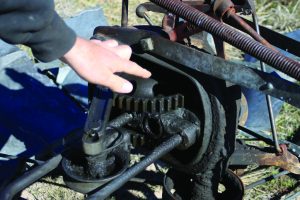Fly over the Sandhills in a plane to check cattle and peer below. If you are along for the ride ask the pilot/rancher to gain a bit of altitude and tack on several miles before landing in the pasture by his shop. The dunes, stabilized by grass and other vegetation, resemble green waves on the ocean at just the right phase of spring. Taking the comparison further, windmills look like buoys in the semi-arid “sea”.
James Girard, of Alliance-based Girard Well Service, usually maintains a more typical vantage point while installing and maintaining windmills in the area. Though many landowners have added or converted stock wells to solar power he expects the workhorses of the west to remain.
“A lot of guys will triage,” he explained. “They may take a windmill out and use parts. May like to have both (wind and solar) in one pasture. With basic maintenance, windmills will last a long time . . . simple effective design.”
Despite being a dependable, green machine windmills have taken a hit in rural America before. According to “Windmills on the American Plains,” an article posted on the Homestead National Historical Park site of the National Park Service, the 1935 Rural Electrification Act allowed more farms to have electricity, using the power source to pump water. “By the 1960’s, most windmills were sold to developing nations around the world or to three specific cattle ranching regions of the Plains . . . the sandhills of western Nebraska, the panhandle of Oklahoma and Texas, and southwestern Texas,” the article says.

Anyone who works on windmills may deal with equipment and parts around a century old at times. Pointing out an Aermotor-made gearbox in his inventory, James said that particular design was made prior to 1933 – the last time the company changed its basic design. “Some parts have been on 60 years or better,” he commented. “We’re lucky enough our inventory of used windmill parts is probably the biggest in the Panhandle. . . . They’re like the Chevy engine of the world. . . . Because there’s no foundries they’ve become very recycled. You can take four or five that are busted up and make two or three windmill heads.”
Though windmills are durable, working on “all the stuff down the hole is pricey.” Minimum maintenance is usually around $1,000. “If you spread the cost of solar over five years versus pulling a windmill twice over that time it’s hard not to go with solar.”
“I’d say it’s plateaued as far as changing/converting,” James said. “All the new wells are almost all solar for livestock. (We) don’t move windmills (much) anymore. We did have government funding to change from windmills to solar. All the government equipment programs are solar – all the cost-share is solar and pipeline (share with one well to other tanks). Some places (such as Lusk, Wyo., or Whitney, Neb.) it’s more efficient to run pipeline instead of more wells.”
Manpower has become a greater factor when considering ranch infrastructure. James pointed out that more cattle in one area served by a solar well means moving those animals less often. “Now you have a fraction of the employees to do everything.”
Just as Aermotor became a lasting and preferred brand, James said the solar market is dominated by two major brands and a “knock-off of one”. New owners of a system benefit from a 5-year warranty though “I have (had) some in for 12-15 years and haven’t touched panels or pumps. Had a 6-panel system that wasn’t scratched in the big hail storm a few years ago,” he said. The panels, all from China after an Oklahoma company went out of business, are rated at 60 miles per hour/1.5-inch hail.
Technology continues to advance with solar pumping systems. James described one 110 volt AC/DC design where you can plug a generator in. A new model is expected to pump from depths up to 400 feet and the same pumping power is possible with fewer panels in an array.
Technology or tradition, the cattle on a thousand hills drink their fill.

